

GREEN JUNE BEETLES and SCOLIA WASPS cruising over lawns and feeding on fruits and vegetables;
FALL WEBWORMS on a variety of trees;
SOYBEAN aphids on soybean;
MILLIPEDES invading homes in some areas;
WALNUT CATERPILLARS on walnuts and some other trees.


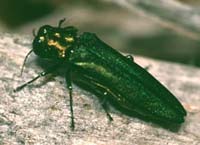 Anyone suspecting an EAB infestation should call the Hotline at (866) 322-4512. Staff there will obtain
information from you and may send someone to inspect the site. You can get extensive information on
this insect at the EAB web page for Kentucky
http://pest.ca.uky.edu/EXT/EAB/welcome.html.
Anyone suspecting an EAB infestation should call the Hotline at (866) 322-4512. Staff there will obtain
information from you and may send someone to inspect the site. You can get extensive information on
this insect at the EAB web page for Kentucky
http://pest.ca.uky.edu/EXT/EAB/welcome.html.


 No additional cases of blue mold have been reported since the disease was found June 13 in Fayette County. The overall risk of tobacco to blue mold in Kentucky appears low at this time. The hot, dry weather we've experienced in recent weeks has been unfavorable for infection and spread of blue mold; however, there have been periods of rain and cooler temperatures, particularly after the 4th of July. To be on the safe side, growers should scout tobacco in the field for the presence of blue mold. Begin preventive applications of fungicide if disease is found. Unused tobacco transplants should be destroyed to eliminate a potential source of inoculum should they become infected.
No additional cases of blue mold have been reported since the disease was found June 13 in Fayette County. The overall risk of tobacco to blue mold in Kentucky appears low at this time. The hot, dry weather we've experienced in recent weeks has been unfavorable for infection and spread of blue mold; however, there have been periods of rain and cooler temperatures, particularly after the 4th of July. To be on the safe side, growers should scout tobacco in the field for the presence of blue mold. Begin preventive applications of fungicide if disease is found. Unused tobacco transplants should be destroyed to eliminate a potential source of inoculum should they become infected.
We are still seeing quite a bit of black shank, and a higher-than-normal number of cases of Fusarium wilt. It is important to realize that these diseases can be spread easily by movement of contaminated soil, so good sanitation is critical in reducing spread of inoculum from infested fields to clean areas. It's a good idea to wash equipment (and boots) with a 10% solution of bleach (1 part bleach to 9 parts water) when moving between areas with either black shank or Fusarium wilt to fields that don't have these problems. There are no fungicide options for Fusarium wilt; mefenoxam (Ridomil Gold or Ultra Flourish) may be used for management of black shank in crops that can be cultivated. Growers should also plan to rotate away from fields with either disease in 2008, and should realize that long rotations (4+ years) may be needed to significantly reduce pathogen populations to tolerable levels in the case of Fusarium wilt. Resistant varieties are important considerations for management of black shank and Fusarium wilt. Unfortunately, varieties with good levels of resistance to Fusarium wilt may not have acceptable resistance to black shank. Refer to the "2007 KY Tobacco Production Guide" (ID-160) for more information, or consult KPN #1133 (June 25, 2007) to learn more about management of black shank during the growing season.
Tomato spotted wilt (TSW) has increased dramatically over the past few weeks. This disease, transmitted by thrips, causes a variety of symptoms that include stunting, wilting, leaf spots, necrotic lesions on stems, and root necrosis. Management of TSW has proven difficult in areas south of KY. Weed control early in the season is believed to reduce reservoirs of both the virus and insect vector, and some studies have shown that early-season control of thrips can provide modest reductions in the incidence of TSW.
Please let me know if you find blue mold or suspect it in your area. You can visit the Kentucky Tobacco Disease Information page for regular updates on blue mold and other diseases (http://www.uky.edu/Ag/kpn/kyblue/kyblue.htm).
For the latest blue mold status and other tobacco disease information, check the KY Blue Mold Warning System online.
![]() http://www.uky.edu/Agriculture/kpn/kyblue/kyblue.htm
http://www.uky.edu/Agriculture/kpn/kyblue/kyblue.htm
A single or a few wilted tobacco leaves on otherwise healthy plants usually is the result of stink bug feeding. Most injury is caused by the brown stink bug, a 1/2" long brown, shield shaped insect with a light yellow underside. This collapsed top was found on July 9 and the culprit was still there. Often, the insect has flown away before the damage appears but wilting occurred quickly on this hot day.
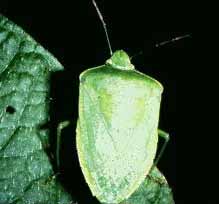
Stink bugs are sap feeders. Enzymes they inject while feeding cause nearby plant tissue to wilt. On hot, sunny days wilted leaves can scald. Sometimes most of the leaf recovers almost completely with the only permanent damage being dead tissue about the diameter of a quarter immediately around the feeding site. The dead tissue will drop out leaving holes surrounded by yellow to brown areas.
Initial symptoms may show up in just a few minutes but often the culprit is long gone by the time the injury is apparent and its signs are scattered across the field. Insecticide sprays in response to symptoms usually are ineffective. Stink bugs are good fliers and move frequently from plant to plant, as well as into and out of the field. Because of their transient nature and generally minimal damage, insecticide applications specifically for stink bug are rarely justified.

For more information about tobacco pests, visit "Insect Management Recommendations".

Growers need to continue monitoring for western corn rootworm beetles during mid July. During this period, decisions will be made on a field by field basis on the need for corn rootworm management next year. Several third-year corn fields in western Kentucky have had excessive numbers of adult beetles in the last two weeks. A few of these fields had enough beetle feeding to cause severe silk clipping and the potential for pollination interference to warrant control sprays.
Growers should walk their fields and record the average number of beetles per plant. The standard sample is 20 consecutive plants in a location with the number of locations being dependent on the size of the field. If at any point this summer, the average number of beetles per plant exceeds 1 per plant, then control of the larvae is needed in 2008.
Fields that exceed the economic threshold have several options. In Kentucky, the easiest option is to plant another crop other than field corn, popcorn, or sweet corn. If the field is rotated to another crop, then no other treatment is needed for corn rootworms. The following year, 2009, there should be little risk of rootworm damage if the field is planted again in corn. If corn will be planted in these fields in 2008, then an at-planting insecticide (liquid or granular), a seed treatment targeting rootworm beetles (higher seed treatment rates), or a Bt corn hybrid specifically for corn rootworm is needed. See ENT-16 for a complete list of treatment alternatives.
For information about corn pests, visit
"Insect Management Recommendations".


Botrytis bunch rot (gray mold) is caused by the fungus Botrytis cinerea. The fungus causes blight of leaves, shoots, and blossom clusters and occurs wherever grapes are grown. The fungus causing the disease grows and reproduces on senescent or dead plant tissue. Botrytis bunch rot is especially severe in grape cultivars with tight, closely packed clusters of fruit. Botrytis is also responsible for storage losses of grapes picked for fresh market. This is the time of the growing season to prepare for the pre-harvest sprays that may be needed to manage bunch rot.
Symptoms. Botrytis infection of leaves often begins near a leaf vein, appearing as a dull, green spot which rapidly becomes a brown necrotic lesion. The fungus may also cause a blossom blight or a shoot blight, which can result in significant crop losses. The most common symptom is the infection and rot of ripening berries. Fruit rot can spread rapidly throughout the cluster. Infected berries of white cultivars often become brown and shriveled, and those of purple cultivars develop a reddish color. Under moist weather conditions, the fungus produces a fluffy, gray-brown growth containing spores.
Disease history. The fungus overwinters as dark, hard, resting structures called sclerotia on debris in the vineyard floor and on the vine. Sclerotia are resistant to adverse weather conditions and usually germinate in spring. Germinated sclerotia produce conidia, which spread the disease. Conidia may also occur on debris left on the vine during the previous growing season, such as cluster stems remaining after harvest or mummified fruit. Although germinating conidia may penetrate directly into ripe berries, the fungus usually gains a foothold by colonizing injured or dead tissue prior to infection of healthy tissue. Tissue injured by hail, wind, birds, other diseases or insects is readily colonized by Botrytis. Ripe berries that split because of internal pressure or because of early season infection by powdery mildew, are especially susceptible to infection by Botrytis. Botrytis conidia are usually present in the vineyard throughout the growing season. Moisture in the form of fog or dew and temperatures of 59?F to 77?F are ideal for conidia production and infection. Rainfall is not required for disease development, although periods of rainfall are highly conducive to disease.
Botrytis Bunch Rot Disease Management.
 Grape root borer (GRB) moths are now active and growers need to be monitoring the vineyards for their presence. GRB is often a pest that takes growers by surprise when vines begin to decline and die. It usually takes several years for problems to develop, but when this insect pest strikes, the damage can be severe.
Grape root borer (GRB) moths are now active and growers need to be monitoring the vineyards for their presence. GRB is often a pest that takes growers by surprise when vines begin to decline and die. It usually takes several years for problems to develop, but when this insect pest strikes, the damage can be severe.
It takes two years for the GRB to complete its life cycle. Larvae are cylindrical, cream-colored, with three pairs of true legs near the head and five pairs of fleshy abdominal prolegs each bearing two bands of tiny hooks. The larvae are 1-1/2 inch long when mature and have a retractable brown head. Adult moths are active during a period of several weeks. Adults are brown moths with thin yellow bands on the abdomen and resemble some paper wasps. The front wings are brown while hindwings are clear. Male moths fly about in a manner similar to wasps. Generally the moths are active from July through early August.
Eggs are laid on the soil surface, grape leaves, and weeds within eight days of adult emergence. Females lay an average of 350 eggs. Eggs hatch in about two weeks and larvae immediately tunnel into the soil in search of grape roots. About 95% of the larvae die before reaching roots, but less than 1% die after finding grape roots. The larvae spend 22 months feeding in the roots. During the summer of the second year, larvae will pupate near the soil surface.
Injury by GRB is often most severe in low, poorly drained areas of the vineyard. In mid-summer, growers should examine around the bases of vines out to a distance of 18 inches for empty pupal skins of grape root borer.
In Kentucky, a control action for GRB is recommended if more than 5 percent of the vines are found to have GRB pupal cases emerging from the soil. If an insecticide is to be used, then it is best to apply the insecticide just as the adults are beginning to emerge, but the preharvest interval may make it necessary to spray after harvest. The insecticide should be applied as a coarse spray to a 15 square foot area surrounding the vine. Treat with an insecticide only if necessary. If GRB is not a problem, there is no reason to risk destroying the natural control processes and increasing production costs.

Downy mildew has been reported on cucurbit crops in Canada, Ohio, Michigan, New York, North Carolina, South Carolina, and Texas in recent weeks. It does not appear that the disease has reached KY; however, the early appearance of downy mildew in northern states could signal an earlier-than-normal outbreak in the Commonwealth. Downy mildew on cucurbits is an aggressive, fast-moving disease and can be really hard to stop when it gets started. Under the right conditions, infection levels can go from 10% of leaf area infected to 90-100% in less than a week!
Identifying downy mildew on cucurbits can be a little tricky, because symptoms on each species vary to some degree. What's more, downy mildew can be confused with powdery mildew. Both of these diseases are similar in that they are caused by obligate pathogens, meaning that the pathogen must be associated with a host plant to survive. The downy mildew pathogen, Pseudoperonospora cubensis, is not a true fungus. It belongs to the Oomycetes and is related to the pathogen that causes blue mold of tobacco; however, powdery mildew is caused by Podosphaera xanthii and belongs to the Ascomycete group of "true" fungi. Although downy mildew is more common in wet weather, fogs and heavy dews can contribute enough moisture to allow infection during "dry" weather. Powdery mildew is more likely to be a problem when conditions are hot and dry, and it tends to develop gradually over the course of several weeks.
In terms of symptoms, the two diseases can be confused. Early on, both can cause yellow spots on the upper surface of a leaf. In the case of downy mildew, leaf spots tend to be small, blocky, and are limited by leaf veins, while spots associated with powdery mildew are round and somewhat diffuse. On the underside of a leaf with downy mildew, lesions will initially appear sunken and slightly water-soaked. As downy mildew progresses, infected leaves will take on a scorched appearance. Leaf yellowing (chlorosis) is more common with powdery mildew, and infected leaves will be covered with a white, talc-like, superficial growth (from which powdery mildew takes its name) that tends to favor the upper leaf surface; however, it is not uncommon to find colonies of the powdery mildew fungus on lower leaf surfaces, stems, or vines if disease is severe. The powdery growth consists of mycelium and conidia (spores). One of the key features of downy mildew is the pattern of sporulation, which occurs only on the underside of an infected leaf and has a faint, fuzzy or "downy" appearance. It is generally easier to observe sporulation with downy mildew in the morning when there's plenty of leaf wetness. It's very easy to distinguish the downy and powdery mildew pathogens at the microscopic level; sporangia of downy mildew are formed on sporangiophores that have a distinctive branching pattern that gives them the appearance of "deer antlers". Conidia of powdery mildew are formed in chains on relatively simple structures. If downy mildew is suspected, send a sample in to the Plant Disease Diagnostic Lab in Lexington or Princeton for examination.
We need to keep an eye on all cucurbit crops and act as quickly as possible if downy mildew is found. The good news is that downy mildew can be controlled with preventive applications of several fungicides, many of which may already be in use as part of a regular disease management program. The following list was adapted from ID-36 (2006-07 Vegetable Production Guide for Commercial Growers):
Please note that products containing mancozeb (Dithane, Manzate, Penncozeb, Gavel, etc) cannot be applied to pumpkins. Maneb or Manex, an EBDC fungicide similar to mancozeb, can be used on pumpkins. Each product has a limit on the number of applications that can be applied - consult the label for specific information. Resistance management practices should be followed with products such as Quadris, Cabrio, Amistar, Pristine, Reason, Acrobat/Forum, and Flint - do not make back-to-back applications of these products; rotate with products containing different modes of action. Please be aware that strobilurin-insensitive strains of the downy mildew pathogen are common, and will limit the effectiveness of these materials (Amistar, Cabrio, Quadris, Pristine, Reason) should we encounter insensitive strains. In general, excellent protection against downy mildew can be achieved with EBDC's (mancozeb and maneb) or chorothalonil. To be effective, these products should be applied before disease is observed. If downy is observed before fungicides have been applied, use a product such as Gavel or Ridomil Gold Bravo. If your growers are not using fungicides at the moment, encourage them to put out an application soon to prevent problems and urge them to stay on a regular schedule. Given the hot and dry weather, a longer spray interval can be used to save on fungicide costs and still provide good protection against downy mildew and other diseases.
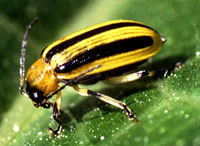
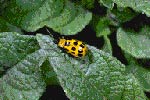 Most at-planting treatments for cucumber beetles have run their course and the first generation adults are beginning to emerge. While transmission of the bacterium that causes bacteria wilt remains a possibility with cucurbits that are susceptible to bacterial wilt, beetles causing direct damage to the developing rinds of the fruits are the primary concern. The adult beetles will often feed on the lower side of the fruits near where they rest on the ground.
Most at-planting treatments for cucumber beetles have run their course and the first generation adults are beginning to emerge. While transmission of the bacterium that causes bacteria wilt remains a possibility with cucurbits that are susceptible to bacterial wilt, beetles causing direct damage to the developing rinds of the fruits are the primary concern. The adult beetles will often feed on the lower side of the fruits near where they rest on the ground.
Growers should continue to monitor for striped and spotted cucumber beetles before and during harvest. Growers may need to apply an insecticide to control the adults and attention should be given to achieving thorough coverage beneath the canopy and on the undersides of the fruits. Selection of insecticides will depend on the anticipated harvest date and the preharvest intervals of the various products. For a complete list of recommended products, check ID-36, Vegetable Production Guide for Commercial Growers.


Fairy rings, circles or arcs of dark green grass, are evident in some lawns, especially if under-fertilized. Sometimes the arcs and rings may have dead or drought-stressed grass, as well. Fairy rings are caused by certain mushroom-producing fungi. These fungi inhabit the soil and feed on decaying organic matter in the soil and, in that sense, they serve an important ecological role.
While they don't actually infect the roots of affected grasses, fairy ring fungi cause symptoms which may seem undesirable. The dark green color is due to the release of nitrogen as the fungi decompose organic matter. The drought-stressed or dead grass is due to the fungi producing a hydrophobic coating on soil particles, which repels water and causes drought stress on the grass in the vicinity of the fungus.
A fertility program can help to mask the symptoms of fairy ring. A normal, moderate fertility program for a cool-season grass would be to apply 1 to 1.5 lb nitrogen per 1000 sq ft in October and again in December, with a quick-release fertilizer in both cases. If rings or arcs of dead grass are apparent, application of a soil surfactant followed by regular irrigation often helps to alleviate symptoms. Also, reducing thatch accumulation can help somewhat.
Fungicides for fairy rings were discussed in an article published last week. However, acceptable management of the symptoms associated with fairy rings in lawns and landscapes is usually possible without fungicides. Furthermore, I discourage the general use of fungicides on home lawns because of concerns for reducing the overall human exposure to pesticides as well as reducing environmental contamination.
Hundreds of Scolia wasps buzzing lazily over expanses of turf can be a troubling site except that these distinctive insects are working hard to parasitize as many white grubs as possible. While packing a stinger, these solitary hunters pose no threat to us. They are following their own agenda, a tireless search for grubs down in the soil feeding on grass roots.
A Scolia wasp has a black head, thorax and wings. The front of the abdomen is black, the back is dark
orange with two distinct yellow bars. Cruising females will occasionally enter the soil in search of
white grubs, which serve as food for the wasp larva. These wasps can be very abundant in turf where
white grubs are numerous; however, the wasps are not aggressive, they are not defending a nest as
would social wasps such as yellowjackets and hornets. There is no need for control.


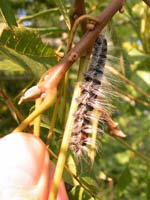 Walnut caterpillars are black and covered with long, fine white hairs. There is a single white line along each side and a thin, broken white line down the center of the back. These caterpillars feed on black and English walnut, butternut, pecan and several hickory species. Eggs are laid in masses of 100 to 800 so large numbers of larvae can be found stripping entire branches. By now many of the caterpillars are full grown (about 2" long). Trees usually can withstand 2 or 3 years of heavy defoliation before showing adverse effects on large established trees. Infested branches with the caterpillars can be remove and destroyed.
Walnut caterpillars are black and covered with long, fine white hairs. There is a single white line along each side and a thin, broken white line down the center of the back. These caterpillars feed on black and English walnut, butternut, pecan and several hickory species. Eggs are laid in masses of 100 to 800 so large numbers of larvae can be found stripping entire branches. By now many of the caterpillars are full grown (about 2" long). Trees usually can withstand 2 or 3 years of heavy defoliation before showing adverse effects on large established trees. Infested branches with the caterpillars can be remove and destroyed.


Agronomic samples over the past week included black shank, sore shin, tomato spotted wilt virus, manganese toxicity, temporary phosphorus deficiency, and Fusarium wilt on tobacco; and Rhizoctonia root/ stem rot and potassium deficiency on soybean.
On fruit and vegetable samples we have diagnosed cedar/ apple rust on apple; fire blight on apple and pear; black knot on plum; black rot on grape; blossom end rot and early blight on tomato; wirestem on cabbage; anthracnose on cucumber; and bacterial leaf spot on pepper.
On ornamentals and turf we have seen Verticillium wilt on redbud; anthracnose on maple; brown patch on fescue; summer patch on annual bluegrass; anthracnose on bentgrass; and fairy ring on bentgrass.


June 29-July 6, 2007
UKREC-Princeton, KY
| Black Cutworm
| 0
| True Armyworm
| 28
| Corn Earworm
| 2
| European Corn Borer
| 0
| Southwestern Corn Borer
| 7
| Fall armyworm
| 0
| | |
Jackson, TN
| Black Cutworm
| 0
| True Armyworm
| 0
| Corn Earworm
| 0
| European Corn Borer
| 0
| Southwestern Corn Borer
| 6
| Fall armyworm
| 0
| | |
Milan, TN
| Black Cutworm
| 0
| True Armyworm
| 0
| Corn Earworm
| 0
| European Corn Borer
| 0
| Southwestern Corn Borer
| 4
| Fall armyworm
| 0
| | |
Lexington, KY
| Black Cutworm
| 0
| True Armyworm
| 82
| Corn Earworm
| 0
| European Corn Borer
| 0
| Southwestern Corn Borer
| 0
| Fall armyworm
| 0
| | |
Fall armyworm 0
This season insect trap counts will be provided for locations in Kentucky and Tennessee.
View trap counts for past seasons and the entire 2007 season at -
http://www.uky.edu/Ag/IPMPrinceton/Counts/2006trapsfp.htm
View trap counts for Fulton County, Kentucky at -
http://ces.ca.uky.edu/fulton/anr/
For information on trap counts in southern Illinois visit the Hines Report at -
http://www.ipm.uiuc.edu/pubs/hines_report/comments.html
The Hines Report is posted weekly by Ron Hines, Senior Research Specialist, at the
University of Illinois Dixon Springs Agricultural Center.
NOTE: Trade names are used to simplify the information presented in this newsletter. No endorsement by the Cooperative Extension Service is intended, nor is criticism implied of similar products that are not named.
Lee Townsend
Extension Entomologist